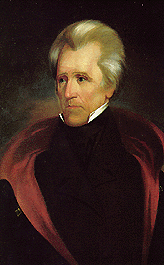|
Overview
| President Andrew Jackson |

|
| Indian Removal |
With the onset of westward expansion and increased contact with Indian
tribes, President Jackson set the tone for his position on Indian affairs in his message
to Congress on December 6, 1830. Jackson’s message justified the removal policy already established by the Indian Removal Act of May 28, 1830.
The Indian Removal Act was passed to open up for settlement those lands
still held by Indians in states east of the Mississippi River, primarily Georgia, Tennessee, Alabama, Mississippi, and North
Carolina. Jackson declared that removal would “incalculably strengthen the southwestern frontier.” Clearing Alabama and Mississippi of their Indian populations, he said, would “enable those states
to advance rapidly in population, wealth, and power.” It is referred to as Manifest Destiny.
White inhabitants of Georgia were particularly
anxious to have the Cherokees removed from the state because gold had been discovered on tribal lands. Violence was
commonplace in Georgia, and in all likelihood, a portion of the tribe would have been decimated if they had not been removed.
Removal of the Indian tribes continued
beyond Jackson’s tenure as President. The most infamous of the removals transpired in 1838, two years after the end
of Jackson’s final term, when the Cherokee Indians were forcibly removed by the military. Their journey west became
known as the “Trail of Tears,” because of the thousands of deaths along the way.
(Source: National Archives)
Recommended
Reading: Trail of Tears (Hardcover). Description: Insightful, rarely told history of Indian courage in the face of White expansionism in the 19th century. Truth-telling
tale of the ruthless brutality that forced the Native American population into resettlement camps and reservations, with a
look at the few white Americans who fought to help them. This is an amazing book. Continued below...
Tireless research
and the author's gift of vision and words produce a magnificently readable narrative of the American Indian Removals. It is
very balanced with no point of view overlooked. Include many surprising appearances and plenty of twists which will make you
laugh out loud and break your heart. A very human book and an absolute must-read for anyone who wants to learn history through
the eyes and ears (and hearts) of those that experienced it. You won't be able to put it down.
Recommended Reading: Indian
Removal (The Norton Casebooks in History). Description: This casebook traces the evolution of U.S. Indian
policy from its British Colonial origins to the implementation of removal after 1830. Continued below...
Placing Indian removal in political and social contexts, the editors have selected contemporary primary-source
documents that reveal the motives and perspectives of both whites and Indians and cover the complicated influences of Jacksonian
Democracy and the early stirrings of what would later be referred to as Manifest Destiny. Letters, treaties, and journal entries
give readers a sense of the ordeal of removal for American Indians.
Recommended
Reading: Indian
Removal: The Emigration of the Five Civilized Tribes of Indians (423 pages) (University of
Oklahoma Press)
Recommended
Reading: Atlas of the North
American Indian. Description: This unique resource covers the entire history, culture, tribal
locations, languages, and lifeways of Native American groups across the United States,
Canada, Central America, Mexico, and the Caribbean. Thoroughly updated, Atlas of the
North American Indian combines clear and informative text with newly drawn maps to provide the most up-to-date political and
cultural developments in Indian affairs, as well as the latest archaeological research findings on prehistoric peoples. The
new edition features several revised and updated sections, such as "Self-Determination," "The Federal and Indian Trust Relationship
and the Reservation System," "Urban Indians," "Indian Social Conditions," and "Indian Cultural Renewal." Continued below...
Other updated
information includes: a revised section on Canada, including Nunavut, the first new Canadian territory created since 1949,
with a population that is 85% Inuit; the latest statistics and new federal laws on tribal enterprises, including a new section
on "Indian Gaming"; and current information on preferred names now in use by certain tribes and groups, such as the use of
"Inuit" rather than "Eskimo."
Try the search engine for related studies: President Andrew Jackson and the Trail of Tears,
History of the Indian Removal Acts, Timeline of the Cherokee Indian Removal, North Carolina, Native American Indian Territory
Oklahoma, Congress Proclamation.
|

